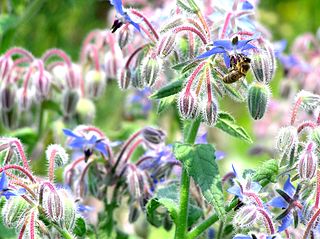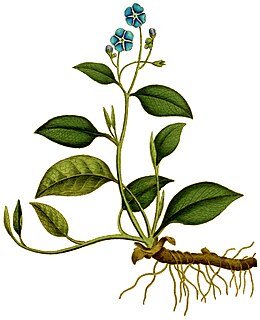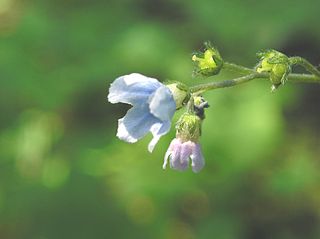
Boraginaceae, the borage or forget-me-notfamily, includes about 2,000 species of shrubs, trees and herbs in 146 genera with a worldwide distribution.

Symphytum is a genus of flowering plants in the borage family, Boraginaceae. There are up to 35 species, known by the common name comfrey. Some species and hybrids, particularly S. officinale and S. × uplandicum, are used in gardening and herbal medicine. They are not to be confused with Andersonglossum virginianum, known as wild comfrey, another member of the borage family.

Botrychium is a genus of ferns, seedless vascular plants in the family Ophioglossaceae. Botrychium species are known as moonworts. They are small, with fleshy roots, and reproduce by spores shed into the air. One part of the leaf, the trophophore, is sterile and fernlike; the other, the sporophore, is fertile and carries the clusters of sporangia or spore cases. Some species only occasionally emerge above ground and gain most of their nourishment from an association with mycorrhizal fungi.

There are many species in the plant genus Cynoglossum. They are coarse-appearing, small-flowered plants of the family Boraginaceae. Cynoglossum officinale, the common hound's-tongue, is a native of Asia, Africa, and Europe. It has been introduced into North America, and it is considered to be a troublesome weed because its burs stick to the wool of sheep and to other animals. Ingestion of this plant can also lead to photosensitivity in grazing animals.

Stegnosperma is a genus of flowering plants, consisting of four species of woody plants, native to the Caribbean, Central America, and the Sonoran Desert. These are shrubs or lianas, with anomalous secondary thickening in mature stems, by successive cambia.

Adelinia grande, previously known as Cynoglossum grande, is a species of flowering plant in the borage family known as Pacific hound's tongue. It is the only species in the genus Adelinia.

James Lauritz Reveal was a U.S. botanist best known for his contributions to the genus Eriogonum and for his work on suprageneric names. His website, at PlantSystematics.org, also presents material on plant taxonomy including the Reveal system. He published extensively on North American flora, was a member of the Angiosperm Phylogeny Group, and was one of the authors of the APG II and APG III classifications.

Cynoglossum officinale is a herbaceous plant of the family Boraginaceae.
Andersonglossum occidentale is a species of flowering plant in the borage family known by the common name western hound's tongue.

Boraginoideae is a subfamily of the flowering plant family Boraginaceae s.s, with about 42 genera. That family is defined in a much broader sense in the Angiosperm Phylogeny Group (APG) system of classification for flowering plants. The APG has not specified any subfamilial structure within Boraginaceae s.l.

Omphalodes (navelwort) is a genus of flowering plants in the family Boraginaceae, widely distributed in the temperate Northern Hemisphere. In spring they produce blue or white flowers similar to forget-me-nots.

Adiantum pedatum, the northern maidenhair fern or five-fingered fern, is a species of fern in the family Pteridaceae, native to moist forests in eastern North America. Like other ferns in the genus, the name maidenhair refers to the slender, shining black stipes.
Ulmus boissieriGrudz.,, a disputed species of elm found in Iran, was identified by Grudzinskaya in 1977. She equated her "new species" with the U. campestris f. microphylla collected in 1859 in Kerman Province and described in his Flora Orientalis (1879) by Boissier, for whom she named it, treating Boissier's specimen as the "type". The tree is endemic the provinces of Kermanshah and Kerman., and also the Zagros forests, growing with Quercus brantii, Celtis australis, Platanus orientalis, Fraxinus sp., and Cerasus mehaleb.

Codon is a small genus of plants from South Africa in the family Codonaceae in the order Boraginales. The genus Codon comprises two species.

Andersonglossum virginianum, known as wild comfrey, is a flowering plant in the borage family native to North America. It is also sometimes called blue houndstongue.

Nepenthes abgracilis is a tropical pitcher plant native to the Philippines. It is known only from northeastern Mindanao, including Mount Legaspi. Little is known about the altitudinal distribution of this species, but the holotype was collected at 670 m.

Pseudomertensia is a genus of flowering plants in the family Boraginaceae. They are perennial herbs with blue or bluish purple flowers. Their natural range is from Iran to the Himalayas. None have been found in China or Russia. P. echioides, and the type species for the genus, P. elongata, are occasionally cultivated as ornamentals.
Mimophytum is a genus of flowering plants in the family Boraginaceae. The species occur in Northeastern Mexico and adjacent areas of Texas, United States. They are similar to the closely related genus Omphalodes but a distinct group.

Patricia Holmgren is an American botanist. Holmgren's main botanical interests are the flora of the U.S. intermountain west and the genera Tiarella and Thlaspi. Holmgren was the director of the herbarium at the New York Botanical Garden from 1981–2000, and editor of Index Herbariorum from 1974–2008.

Andersonglossum is a small genus of plants native to North Americam known as wild comfreys. The genus was named in 2015 by James I. Cohen. As of 2020, it comprises three species, each formerly placed in the genus Cynoglossum:



















